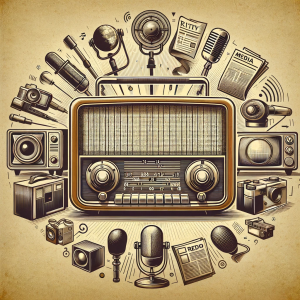Radio, one of the most enduring forms of media, continues to stand strong throughout time. While it’s easy to think that podcasts, live streams, and other contemporary media formats have overshadowed it, radio’s resilience deserves a second look.
Interestingly, the media industry holds a positive outlook on radio. Post-COVID-19, in 2021, investors showed a keen interest in funneling resources into radio, a trend that persists even now. Radio is in fact often regarded as one of the least problematic and least toxic formats of media. It’s notable for its lack of confrontations, scandals, and generally less controversial content compared to other media forms. Some could attribute these fewer cases of controversy given its perceived less interactive nature. However, this statement could not be further away from reality.
In a recent interview, Tom Poleman, chief programming officer at iHeartMedia, told CNBC that interacting with the broadcast is one the main reasons why listeners tune in in the first place. Thus, radio is not as one directional as it seems. This feature along with its accessibility makes it also the main used media outlet for car drivers. In the US, according to Statista, many of the drivers in the country chose to tune in to radio while in their car ride in 2022. Surprisingly, despite the plethora of streaming services available in cars today, like Spotify and YouTube Music, there seems to be a resurgence in the popularity of radio. Could this be attributed to a sense of nostalgia? Recent trends, as highlighted in a WGSN report, suggest that younger generations, including Gen Z, are increasingly drawn to nostalgic elements. This is evident not just in their appreciation for vintage items, but also in their lifestyle choices. For instance, there’s a rising trend in repairing older tech, such as the iPod Classic. Radio, it appears, is enjoying a similar popularity, especially in the United States, where it remains a favored companion for many car drivers.
Moreover, while the industry faces stiff competition from other social media platforms, radio it’s holding its own, thanks in part to the efforts of its professionals. These broadcasters are increasingly adopting strategies akin to popular podcasts, focusing on storytelling and interactive narratives to align with the evolving preferences of their audience. It’s truly remarkable how radio has maintained its presence in the media landscape, especially when compared to the decline of other traditional formats like print news. This leads us to ponder the future of radio. Is it there a renaissance in the near future?
Undoubtedly, the future is digital, and many analysts are optimistic about the evolution of this media format. The emergence of digital assistants, such as Alexa and Google Assistant, has revitalized interest in all forms of audio entertainment, including radio. Technological innovations like binaural sound are also enhancing the radio experience, offering more immersive and personalized audio advertising. Additionally, the incorporation of artificial intelligence into radio’s data-driven content is revolutionizing the way offerings are tailored. For example, AI can significantly enhance the curation of playlists, ensuring that they are more aligned with listener preferences.

In conclusion, it’s clear that radio remains relevant and will continue to do so in the foreseeable future. But can we anticipate a similar resurgence for other traditional media formats? That’s difficult to predict. The adaptability of radio in the face of new competitors has been impressive, and each medium faces its own unique challenges. However, the evolution of radio underscores a significant insight: overcoming traditional media outlets requires more than just the emergence of competitors. This lesson from radio’s resilience could serve as a roadmap for other traditional media formats. By embracing change and leveraging new technological advancements, they too could find ways to prevail as relevant actors in the media sector.

